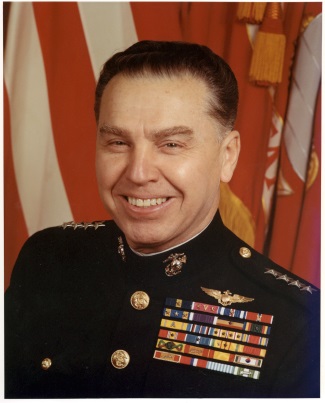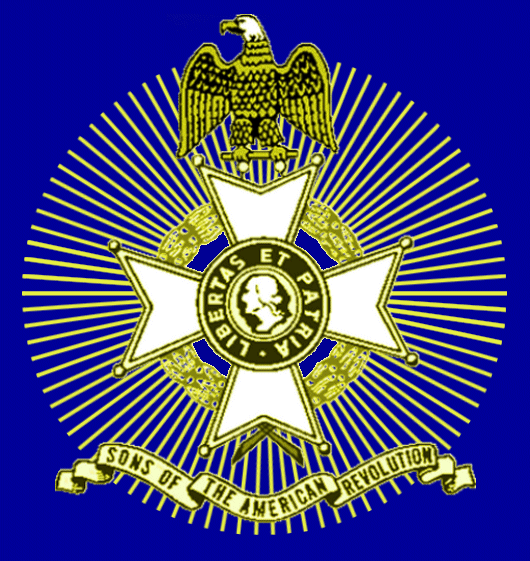General Earl Edward Anderson, USMC (Retired)
General Earl Edward Anderson, the first active duty Marine Naval Aviator to be promoted to a four-star rank, became Assistant Commandant of the Marine Corps on 1 April 1972. He was promoted to general on 31 March 1972 and retired from the Marine Corps in July 1975. Anderson was born 24 June 1919, in Morgantown, West Virginia, and graduated from Morgantown High School. He then entered West Virginia University, and graduated in 1940, after earning a Bachelor of Science degree and academic and military honors. He also holds a Master of Arts degree from that institution. In June 1940, he was commissioned a Marine second lieutenant and reported to Philadelphia, Pennsylvania, for Basic School.

General Earl Edward Anderson, USMC (Retired)
Upon graduation from Basic School, in February 1941, he was ordered to Sea School, Marine Barracks, Portsmouth, Virginia, where he served as an instructor. He remained in that assignment until May, when he received assignment to the USS Yorktown which was operating with the Atlantic Patrol.
With the outbreak of World War II, Anderson and the Yorktown were transferred to the Pacific Area where they participated in the Marshall-Gilbert Campaign, the Salamaua-Lae Raid, and the Battles of the Coral Sea and Midway. He was serving aboard the Yorktown when she was sunk in the Battle of Midway. During this period of time he was promoted to first lieutenant (December 1941) and captain (May 1942).
Following his rescue from the Yorktown, Captain Anderson was returned to the United States where he served briefly with Marine Corps Base, San Diego, California, and then with the 2d Marine Division.
He was ordered to flight training at Naval Air Station, Dallas, Texas, in the spring of 1943. He was promoted to Major in May 1943, and was awarded the gold wings of a Naval Aviator at Pensacola, Florida, in October 1943. His next assignment was a flight instructor at the U.S. Marine Corps Air Station, Edenton, North Carolina. He remained there until December 1944, when he returned to duty in the Pacific area and assumed command of Marine Bomber Squadron (VMB) 443. He later served as Executive Officer, Marine Aircraft Group 61 in the consolidation of the Northern Solomons and in the Philippines.
In November 1945, Anderson returned to the United States where he served in a wide variety of post-war assignments which included the 2d Marine Aircraft Wing; student at the Command and Staff School, Marine Corps Schools, Quantico, Virginia; Superintendent, Military Training, Marine Aviation Technical Schools, Quantico, Virginia; Administrative Officer, Division of Aviation, Headquarters Marine Corps and Administrative Assistant Commandant for Air, Headquarters Marine Corps.
He was promoted to lieutenant colonel in July 1949, and assigned to the Office of the Judge Advocate General, where he served in various branches until summer of 1952. Anderson was next ordered to Aircraft, Fleet Marine Force, Pacific, where he served as Executive Officer for Marine Aircraft Group 16 until the spring of 1953 when he was ordered to Korea.
In Korea, Anderson was Commanding Officer, Marine Observation Squadron Six, and later became the Assistant Chief of Staff G-1, 1st Marine Aircraft Wing. Upon his return to the United States he was assigned as the Executive Officer, and then Commanding Officer, of Marine Aircraft Group 26. During May 1956, Anderson was assigned to Marine Corps Schools, Quantico, Virginia, where he served as an instructor, then Chief, for the Air Section, Marine Corps Educational Center.
He was promoted to colonel in October 1957, and during the summer of 1959, was ordered to the Army War College, Carlisle Barracks, Pennsylvania. He graduated in June 1960, and was ordered to the 3d Marine Aircraft Wing, where he served as the Staff Legal Officer until July, 1961. He then assumed command of Marine Aircraft Group 36, Santa Ana, California, where his group participated in more than 13 separate amphibious and field exercises.
In June 1963, he became Chief of Staff, Military Assistance Advisory Group, Vietnam, and served in that capacity until the summer of 1964, when he returned to the United States. For his service with the MAAG, he was awarded a Legion of Merit with Combat "V"; and for his participation as a pilot in more than 40 combat missions against the Viet Cong, he was awarded gold stars in lieu of his seventh and eighth Air Medals.
Anderson then served as Marine Tactical Data System Program Coordinator, Headquarters Marine Corps, until January 1966. He was promoted to brigadier general on 3 January 1966, and in February he assumed duty as Deputy Chief of Staff (Research, Development and Studies), Headquarters Marine Corps. For that duty he was awarded a Gold Star in lieu of a second Legion of Merit.
In December 1967, he returned to the Far East where he assumed duty as the Chief of Staff, III Marine Amphibious Force, Republic of Vietnam. He held that assignment until January 1969, and for his service he was awarded a Distinguished Service Medal, a National Order of Vietnam (5th Class), a Vietnamese Cross of Gallantry with Palm and a Korean Chungmu Medal. He was promoted 1 September 1968 to major general while serving in Vietnam.
Upon his return to the United States he reported to Headquarters Marine Corps where he served briefly as Special Assistant to the Chief of Staff. In March 1969, he was reassigned as Deputy Director of Personnel, Headquarters Marine Corps.
In 1970 he was appointed as the Marine Corps member on the Board of Directors of the U.S. Olympic Committee, and in March 1971, was designated by the Secretary of Defense as the United States member of the Executive Committee of the Counseil International du Sports Militaire.
He was promoted to lieutenant general in June 1971, and assumed duty as Commanding General, Fleet Marine Force, Atlantic, Norfolk, Virginia, in July 1971.
In addition to his Bachelor of Science and Master of Arts degrees, General Anderson was also the recipient of a Juris Doctor degree in law with highest honors from George Washington University. He served as editor-in-chief of the George Washington University Law Review and was elected to the Order of the Coif.
General Anderson Retired in 1975 and became active in the American Bar Association. By the 1980s he became Director of the General Practice Division, chair of its Government Lawyers Committee and chair of its Federal Legislation Committee. He wrote the “Legislative Update” column for the section’s quarterly magazine for many years. Gen. Anderson’s work led to his appointment as a member of the ABA’s special advisory committee on Programs for Public Sector Lawyers. He strongly advocated for the formation of the ABA Government and Public Sector Lawyers Division and played a vital role in the division’s formative years. Gen. Anderson was appointed by the ABA President to chair two task forces – the Task Force on Risk Management and Avoidance for Volunteer Organizations and the special Committee on Government Lawyers Participation in the ABA.
Of his many leadership positions at the ABA, one that likely holds special significance for him is his role as chair of the Standing Committee on Legal Assistance for Military Personnel. Under his leadership, the committee launched the Military Pro Bono Project, which matches junior-enlisted military members facing civil legal issues with pro bono attorneys. Gen. Anderson’s connections and reputation in the military were essential in convincing the military services to come aboard and view the project as a reliable resource. Since the launch of that program, more than 1,000 military personnel have been helped, representing more than $5.6 million in donated billable hours by volunteer lawyers.
A complete list of his medals and decorations include: a Distinguished Service Medal; a Legion of Merit Medal with Combat "V" and two Gold Stars in lieu of second and third awards; a Distinguished Flying Cross with one Gold Star in lieu of a second award; a Bronze Star Medal with Combat "V;" an Air Medal with one Silver Star and two Gold Stars in lieu of a second through eighth award; a Purple Heart Medal; a Presidential Unit Citation with one Bronze Star; a Navy Unit Commendation with one Bronze Star; an American Defense Service Medal with Fleet Clasp; an American Campaign Medal; an Asiatic-Pacific Campaign Medal with four Bronze Stars; a World War II Victory Medal; a National Defense Service Medal with one Bronze Star; a Korean Service Medal with one Bronze Star; a Vietnam Service Medal with one Silver and one Bronze Star; a National Order of Vietnam Medal (5th Class); a Vietnamese Distinguished Service Order Medal (1st Class); a Vietnamese Cross of Gallantry with Palm; a Korean Chungmu Medal; a United Nations Service Medal; a Philippine Liberation Ribbon; a Korean Presidential Unit Citation; a Vietnamese Meritorious Unit Citation and a Republic of Vietnam Campaign Medal with Device.
Assistant Commandants of the Marine Corps

